Not all of the livestock made it. Below are some of the former inhabitants of the reef tank, along with a brief explanation of the demise or other problem.
|
Orange carnation coral [an error occurred while processing this directive] (or (none)) Dendronepthya sp.
Removed because: The week of 5/14/2003, both seemed to sag and begin decomposing, so I removed the taller one. The second appears to have recovered. Later, on July 18 2003, the rose anemone split (again!), and one of the clones spent a week on top of the remaining carnation. It never recovered. | Adding this may have been a mistake. Carnations apparently feed constantly (on phytoplankton in the water), so the aquarist is torn between keeping it well fed, and spoiling the water quality for the rest of the tank. |
|
Emerald crab [an error occurred while processing this directive] (or ) Mithrax sculptus
Removed because: It was very active when young and small, but grew quickly (tripled in size?) and slowed down. For the last few months, it was very lethargic. Possibly just died of old age? | Algae eater. Very active, although slowing down (sleeping more) as time goes on. Has molted twice. Bold enough to explore the tank, but will quickly hide if it sees rapid movement outside the tank. |
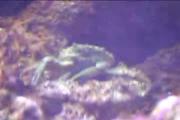
|
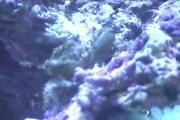
|
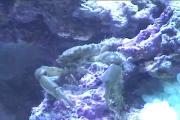
|
|
Green bubble coral [an error occurred while processing this directive] (or ) Plerogyra sinuosa
Removed because: During a protein skimmer failure in June 2003, the polyps all shrank and then decomposed over a couple of days. | Gorgeous and interesting coral. During the day, inflates bright green bubbles for photosynthesis. At dusk, bubbles deflate and tentacles come out, feeding of meaty foods out of the water column. Bubbles (and tentacles) wave slowly in the gentle current. (The second photo shows it eating some Formula One.) This coral is more common found in a pearl white color; the bright green variant is much more interesting, but also much more rare. |
|
Green frogspawn coral [an error occurred while processing this directive] (or ) Euphyllia divisa
Removed because: During a protein skimmer failure in June 2003, the polyps all shrank and then decomposed over a couple of days. | Bright green polyps, waving slowly in the current. Polyps inflate under the light. |
|
Copperband butterfly fish [an error occurred while processing this directive] (or ) Chelmon rostratus
Removed because: Within a couple of days, the tail fin showed signs of battle damage, possibly from the purple tang (although that isn't for certain). Also, for a day, the gills on the right side were red. Within a week the fish had died, for unclear reasons. Soon thereafter, the tank had nitrate troubles which killed a number of corals; perhaps the beginnings of that issue bothered the butterfly fish. | A beautiful and delicate fish, they can be picky eaters. This individual was seen eating frozen mysis shrimp at the LFS (often they only eat live foods), and it did so in my tank as well. Didn't appear to eat anything else, however, including the in-tank aiptasia anemones. As it wasn't the most aggressive eater, it didn't get much of the mysis either. |
|
Bubble-tip anemone [an error occurred while processing this directive] (or ) Entacmaea quadricolor
Removed because: Anemones can move, and often sting stationary corals when they do. So it's hard to keep too many in a community tank. Once I got the rose anemone (which is the same species), this very healthy individual wasn't needed any more, so I sold it back to a LFS. | When happy (?), tips of tentacles form inflated bubbles. Like to eat squid or krill (small shrimp) every couple days. Good host for some clownfish, but rarely for Ocellaris. It was very pale (with bubble tips) when first added. Over time, under intense MH lights, the tentacles turned a dark green and became much longer. (I rarely saw the bubble shape; usually the tentacles were long and straight.) Also, with regular feeding, it doubled in size in a couple of months. |
|
Ocellaris clownfish [an error occurred while processing this directive] (or False Percula) Amphiprion ocellaris
Removed because: Since we wanted to observe a clownfish/host anemone behavior, we decided to get a maroon clown to go with the rose anemone. Different clownfish species aren't compatible in the same tank, so we sold the school of four ocellaris back to a LFS. (The maroon spent about thirty seconds after initial introduction to the tank, before taking up residence in the rose anemone!) | Very cute, poor swimmers, not shy, often in the open water column. Does best in pairs or groups (can get depressed if alone). Our group of four enjoyed schooling together, always in the front and top of the tank. They all learned to eat right out of our hands at the surface of the water. Can live in the tentacles of a host anemone of the right species, but ours never adopted a host anemone. They had a Green Long-Tentacle and Green Bubble-Tip for months, but never showed the slightest interest. (Two of the four, and the largest/most dominant ones, were tank raised, so they may not have learned the symbiotic behavior.) They also had a rose to try for weeks, but similarly showed no interest. |
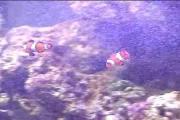
|
|
Camelback shrimp [an error occurred while processing this directive] (or ) Rhynchocienetes uritai
Removed because: Sold back to a LFS, in order to make room for a cleaner shrimp (as Ick insurance) and/or peppermint shrimp (to contain aiptasia anemones). | This was a mistake. We had the beginnings of an aiptasia (glass anemone) infestation, so I wanted to get a peppermint shrimp to contain/eat them. Thought this one was that species, but it isn't. Turns out the aiptasia seems controlled, so who knows: perhaps camelbacks also eat them. Originally very shy: couldn't find it for the first week. Now it enjoys clinging to the (algae on the) glass wall out in the open. |
|
Green long-tentacle sea anemone [an error occurred while processing this directive] (or ) Macrodactyla doreensis
Removed because: Since it was hard to see, and hard to feed (being in the back, behind rocks), and since it wasn't a good clownfish host, and the rose was much prettier anyway, I sold this back to a LFS. | Should enjoy light, but seems to move around and seek partially shaded areas. Unfortunately, many of them are in the back of the tank, making it hard to feed (shrimp, squid) if it rests there. Two attempts were made to move it into the front of the tank, but (after a week or so) it always returned to the back. Not a good clownfish host. Started with nice brown tentacles and red column at first, but has been growing paler over time (due to lack of sufficient light?) |
|
Red sea fan [an error occurred while processing this directive] (or ) Melithaea sp.
Removed because: Sadly, the coral beauty dwarf angel picked at the polyps, and the emerald crab climbed and broke the delicate structure. All that remains is a stump of the trunk. | Tiny white polyps come out of the main red structure when in high current. |
|
Purple firefish [an error occurred while processing this directive] (or ) Nemateleotris decora
Removed because: On 4/10/2003, I noticed one of the two purple firefish had spine bones where the last 1cm of tail should be! Over the next few hours, I got to observe the fire shrimp eating the fish alive (!) from behind. It was still breathing, and sometimes would swim off into the open water. But it soon returned to the sandy bottom under the rocks, and the shrimp would resume eating it! Kind of a aggressive for a 'scavenger' shrimp. In the months before and since, it has never bothered another fish (including the other three firefish that sleep on the sandy bottom under the rocks). | Iridescent colors. Heavy tail appears to be constantly sinking, requiring fish to swim up to maintain level. The pair likes to school together. Generally appears to be a slow swimmer, but can dart amazingly fast if needed. Happy to drift in plain view in the front of tank. |
|
Spiny sea urchin [an error occurred while processing this directive] (or ) Diadema setosum
Removed because: Since we prefer anemones, the urchin was returned to the LFS where it had been purchased. | This was described as a "reef-safe" algae eater. However, within 20 minutes of introduction to the tank, it promptly excreted some kind of acid-like white cloud from its stomach, and began devouring the Sebae sea anemone live. |




Found a meal! Notice how the anemone is half-dissolved, with hard black &
white dead flesh on the upper right.
|
Sebae sea anemone [an error occurred while processing this directive] (or ) Heteractis crispa
Removed because: A "reef safe" sea urchin was introduced, which immediately began devouring this anemone. It didn't make it. | It was white when originally purchased, but under intense lighting the tentacles had begun turning healthy brown (indicating the return of symbotic photosynthetic algae). |
|
Blue starfish [an error occurred while processing this directive] (or ) Linckia laevigata
Removed because: This starfish slowly became less active, and eventually tears appeared in its arms, exposing the white flesh underneath. Finally, parts began disintegrating. It probably starved to death, although it did seem to find food for some time. (And the red starfish remains happy.) | Fun, active starfish. Eats films of algae off the rocks, and in the water column (esp. on the surface). |
One day, the silly starfish decided to go for a walk to the end of the pump...



...and then it began to play gymnast...



...hanging by part of a single tentacle, reaching for the glass...



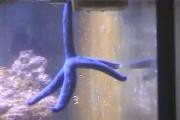
|

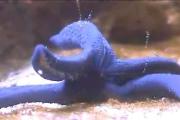
|
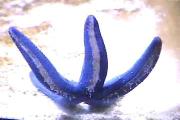
|



|
Regal tang [an error occurred while processing this directive] (or Blue tang) Paracanthurus hepatus
Removed because: Probably developed a case of Ich (but not visible) within a few days. Spent time scratching itself on sand, rocks, and even the emerald crab! It died within a week or so. | Fun, active fish, often swimming in the open water. |
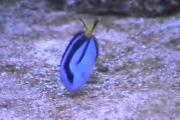
|
|
Mandarin dragonet [an error occurred while processing this directive] (or Mandarin goby) Pterosynchiropus splendidus
Removed because: This one was probably added to the tank too early, and it likely starved to death. | Spent most of the time hiding in the back, resting on the sand bottom. They generally only eat live foods (like copepods and anthropods), which can reproduce in the live rock & sand. |
|
Yellow-tail blue damsel [an error occurred while processing this directive] (or ) Chrysiptera hemicyanea
Removed because: Died almost immediately. Poor acclimation? Yet the clownfish added at the same time did fine. | Supposed to be a hearty fish. Added to help cycle the new tank. |
| webmaster@geddis.org | reef.geddis.org | Last updated 08/19/06 |